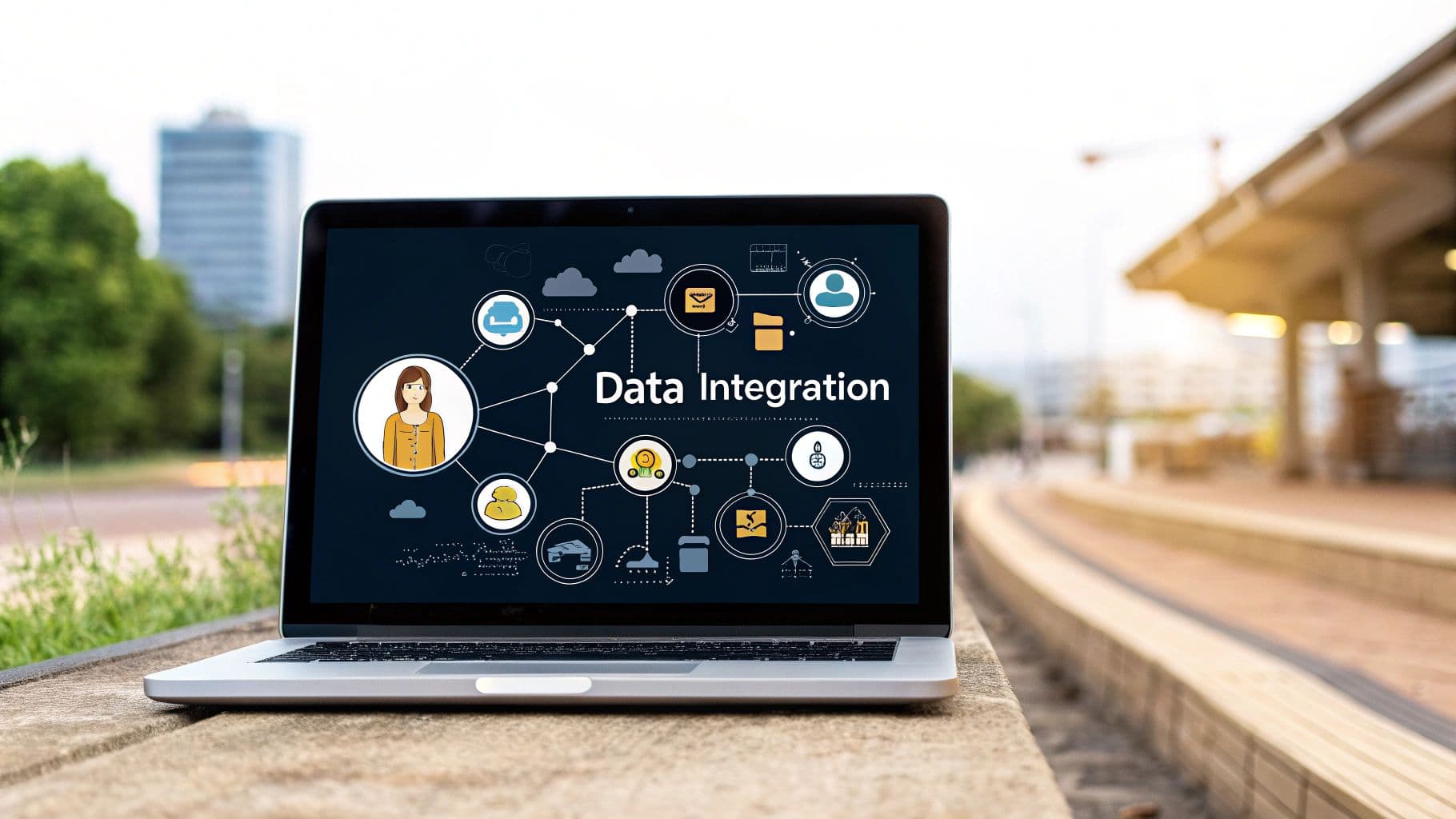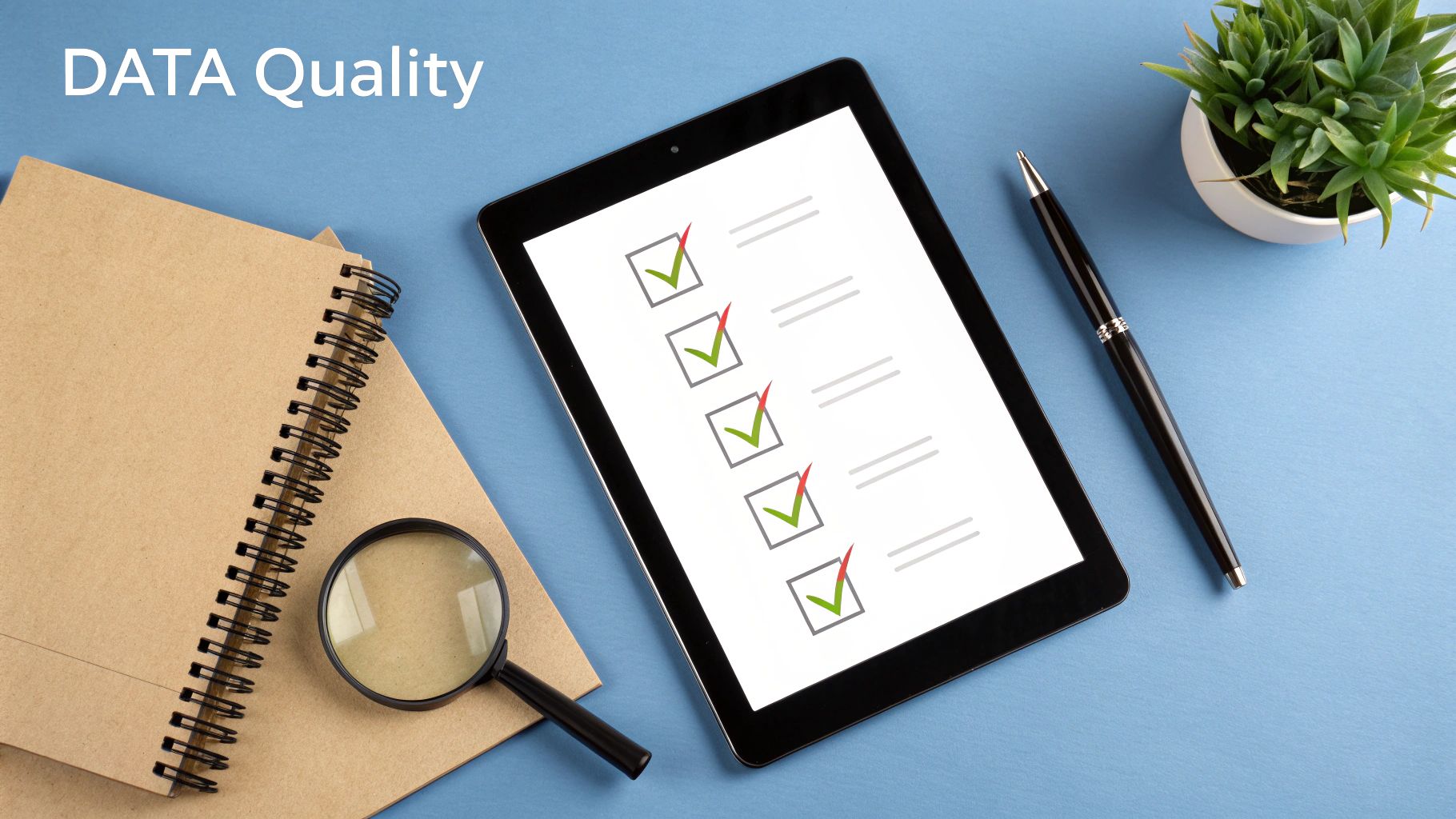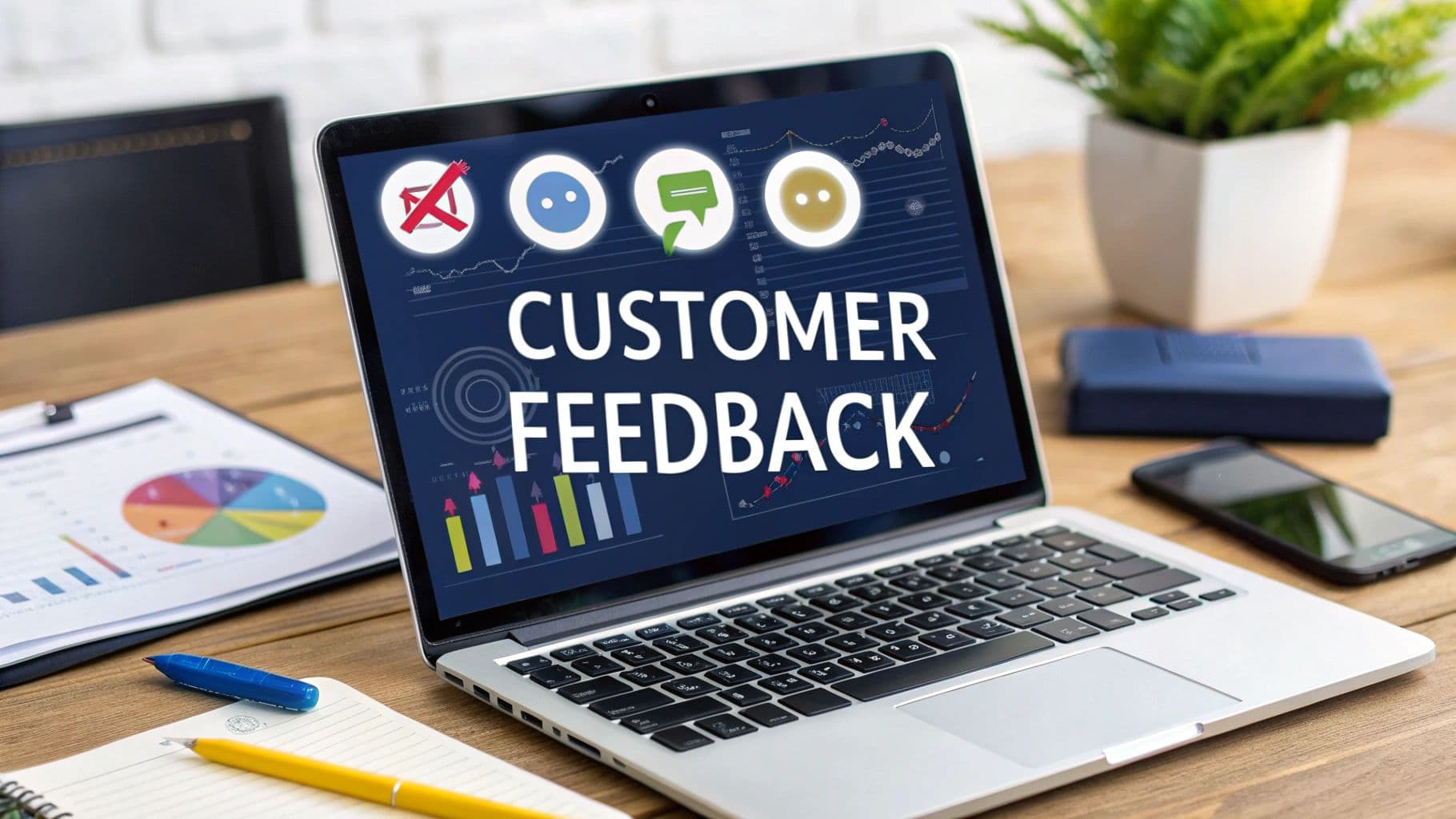7 Customer Data Integration Best Practices for 2025
Discover the top 7 customer data integration best practices to unify data, enhance CX, and drive growth. Actionable tips for a robust data strategy.

In a world driven by data, the ability to create a unified, accurate, and accessible view of your customer is no longer a competitive advantage, it's a fundamental requirement. However, achieving this is fraught with challenges. Fragmented data silos, inconsistent formats, and privacy concerns can turn valuable customer information into a chaotic and unusable liability. This is where a strategic approach to data unification becomes critical for survival and growth.
Adopting proven customer data integration best practices is the key to transforming disconnected data points into a cohesive, actionable asset. This article moves beyond theory to provide a practical roadmap. We will guide you through seven essential practices that empower businesses to enhance decision-making, personalize customer experiences at scale, and unlock significant revenue opportunities.
By mastering these strategies, you can build a reliable data foundation that supports every facet of your organization, from marketing and sales to product development and customer support. You will learn how to implement a single source of truth, manage data quality, ensure privacy compliance, and leverage modern tools like CDPs. Let's explore the specific, actionable steps required to turn data chaos into clarity and competitive power.
1. Establish a Single Source of Truth (SSOT)
A Single Source of Truth (SSOT) is a foundational concept in customer data integration. It refers to the practice of creating one centralized, authoritative repository where all customer information is stored, maintained, and accessed. Instead of having fragmented data spread across your CRM, email marketing platform, support desk, and billing system, an SSOT consolidates this information into a unified, reliable master record for each customer.

This centralized approach ensures that every department, from marketing to customer support, references the same accurate and up-to-date data. The result is the elimination of data silos, conflicting information, and inconsistencies that often lead to poor customer experiences and flawed business intelligence.
Why It's a Top Practice
An SSOT is crucial because it provides a complete, 360-degree view of the customer. When your sales team knows about a recent support ticket and your marketing team can see purchase history, they can deliver more personalized and contextually relevant interactions. This alignment is a key driver for improving customer satisfaction, retention, and lifetime value.
Companies like Salesforce, with its Customer 360 platform, exemplify this by creating unified customer profiles that power every interaction. Similarly, Netflix’s centralized data platform analyzes viewing habits from a single source to power its world-class recommendation engine, demonstrating the immense value of a cohesive data strategy.
Actionable Implementation Tips
Implementing an SSOT is a strategic initiative that requires careful planning. Here are practical steps to get started:
- Prioritize Critical Data: Begin by identifying and consolidating the most critical customer data elements, such as contact information, purchase history, and key interactions. You can expand to include secondary data points later.
- Establish Data Governance: Clearly define roles for data ownership, stewardship, and maintenance. Create a governance framework that outlines who can access, modify, and use the data to ensure accountability and quality.
- Leverage APIs: Use Application Programming Interfaces (APIs) to connect your various systems to the central repository. This enables real-time data synchronization, ensuring the SSOT is always current.
- Conduct Regular Audits: Routinely audit the data within your SSOT for quality, completeness, and accuracy. Implement data cleansing processes to correct errors and remove duplicate entries.
2. Implement Real-Time Data Synchronization
Real-time data synchronization is the practice of ensuring customer data is updated and propagated across all connected systems and touchpoints instantaneously. Unlike batch processing which updates data at scheduled intervals, this approach maintains constant data consistency, giving all departments immediate access to the most current customer information.

When a customer updates their address in your app, places an order, or contacts support, that new information is immediately available to every team. This eliminates the lag that can lead to outdated marketing messages, misinformed sales calls, or frustrating support interactions, making it one of the most critical customer data integration best practices.
Why It's a Top Practice
In today's fast-paced digital environment, customers expect immediate and context-aware interactions. Real-time synchronization powers these experiences by ensuring that every touchpoint reflects the customer's latest activity. This is essential for dynamic personalization, fraud detection, and timely customer service interventions.
For example, Amazon uses real-time data to update inventory levels and power its recommendation engine as you browse, ensuring you see relevant products that are actually in stock. Similarly, Uber’s entire service relies on the instant synchronization of driver and rider location data to function effectively. These examples highlight how real-time data is no longer a luxury but a core operational necessity.
Actionable Implementation Tips
Achieving seamless, real-time synchronization requires a robust technical architecture and clear strategic planning. Here’s how to approach it:
- Prioritize Critical Data: Not all data needs to be synced in real-time. Identify high-priority data elements, like purchase confirmations or support tickets, for instant updates, and use batch processing for less critical information to manage costs and complexity.
- Use Message Queues: Implement tools like Apache Kafka or RabbitMQ to manage data streams. Message queues act as a buffer, handling high volumes of data updates during peak loads and preventing your systems from becoming overloaded.
- Monitor Sync Latency: Continuously monitor the time it takes for data to sync across systems. Set up alerts for significant delays so your technical team can address bottlenecks before they impact the customer experience.
- Implement Circuit Breakers: A circuit breaker is a design pattern that prevents a network or service failure from cascading to other services. If a sync to one system fails repeatedly, the circuit breaker will trip, stopping further attempts for a short period and preventing system-wide slowdowns.
3. Data Quality Management and Validation
Data Quality Management and Validation is the comprehensive process of ensuring that your customer information is accurate, complete, consistent, and reliable. This practice goes beyond a one-time cleanup; it involves implementing automated validation rules, routine data cleansing, and continuous monitoring throughout the data lifecycle. It ensures the information integrated from various sources can be trusted for critical business decisions and customer interactions.

Without strong data quality management, even the most sophisticated customer data integration strategy will fail. Integrating flawed, duplicate, or incomplete data simply centralizes bad information, leading to misguided marketing campaigns, poor customer service, and inaccurate analytics. This practice is foundational to building a data-driven culture that relies on trustworthy insights.
Why It's a Top Practice
High-quality data is the fuel for personalization, effective segmentation, and predictive analytics. When you can trust your data, you can confidently automate processes, make strategic decisions, and deliver superior customer experiences. Inaccurate data, on the other hand, erodes customer trust and wastes resources.
Companies like Capital One leverage automated data quality checks to prevent fraudulent transactions by validating customer information in real-time. Similarly, LinkedIn implements rigorous profile data validation to maintain the integrity of its professional network, ensuring that the information users see is reliable. These examples highlight how data quality is not just a technical task but a core business function. For more information on this topic, learn more about enterprise data analytics.
Actionable Implementation Tips
Implementing a robust data quality framework is essential for successful customer data integration best practices. Here are practical steps to get started:
- Define Data Quality Rules: Establish clear, business-driven rules for what constitutes high-quality data. Define standards for accuracy (e.g., valid email formats), completeness (e.g., required fields), and consistency (e.g., standardized state abbreviations).
- Implement Validation at Entry: Prevent bad data from entering your systems in the first place. Use forms with real-time validation, address verification tools, and automated checks at every point of data capture.
- Use Data Quality Scorecards: Create and monitor data quality scorecards or dashboards. These reports provide a clear view of your data's health, help you track improvements over time, and hold teams accountable.
- Train Staff on Best Practices: Educate all employees who handle customer data on the importance of data quality and the specific procedures they need to follow. A well-informed team is your first line of defense against poor data.
4. Privacy-by-Design Architecture
Privacy-by-Design is an approach that embeds data privacy measures directly into the architecture of your systems from the very beginning. Instead of treating privacy as an afterthought or a compliance checklist item, this practice makes it a core component of your entire customer data integration strategy. It ensures that principles like consent management, data minimization, and purpose limitation are foundational to how data is collected, stored, and used.

This proactive stance not only helps in meeting regulatory requirements like GDPR but also builds significant customer trust. By designing systems to protect user data by default, you demonstrate a genuine commitment to privacy, which is a powerful differentiator in today's data-sensitive world.
Why It's a Top Practice
In an era of increasing data breaches and stringent privacy laws, a reactive approach to data protection is no longer viable. Privacy-by-Design is a critical best practice because it mitigates risks before they become liabilities, reduces the cost of compliance, and strengthens customer relationships. It shifts the focus from "what can we legally do with data" to "what should we ethically do with data."
Tech giants have pioneered this model. Apple uses differential privacy to collect usage data from iOS devices without compromising individual user identities. Similarly, Google’s Federated Learning approach allows it to train machine learning models on user data stored on devices, ensuring the raw data never leaves the user’s control. These examples showcase how robust privacy can be a competitive advantage, not a business constraint.
Actionable Implementation Tips
Adopting a Privacy-by-Design framework requires a cultural and technical shift. Here’s how to integrate it into your customer data integration practices:
- Conduct Privacy Impact Assessments (PIAs): Before launching any new data integration project, perform a PIA to identify and minimize potential privacy risks from the outset.
- Implement Granular Consent: Design systems that capture explicit and granular consent. Allow users to choose precisely what data they share and for what purpose, and make it easy for them to revoke consent at any time.
- Use Pseudonymization and Anonymization: Employ techniques to de-identify personal data wherever possible. Use pseudonymization for internal processing and full anonymization for analytics to reduce the risk of exposure.
- Design for Data Portability and Deletion: Build tools and processes that allow customers to easily access, export, and delete their data, fulfilling their "right to be forgotten" and "right to data portability" as mandated by many regulations.
5. Implement a Customer Data Platform (CDP)
A Customer Data Platform (CDP) is a powerful, packaged software system designed specifically to master customer data integration. It collects first-party customer data from numerous sources, cleans and unifies it, and then constructs a single, coherent, and persistent profile for each customer. This unified database is then made accessible to other systems, like your marketing automation, analytics, and CRM tools, to power data-driven decisions.
Unlike data warehouses that are often IT-managed and handle broad business data, CDPs are typically marketer-managed and laser-focused on customer data. They excel at identity resolution, stitching together anonymous and known user activity across devices and channels into one comprehensive customer view.
Why It's a Top Practice
Implementing a CDP is one of the most effective customer data integration best practices because it democratizes access to unified, actionable customer profiles. It bridges the gap between raw data collection and strategic activation, enabling teams to execute highly personalized campaigns, improve customer journey orchestration, and deliver consistent omnichannel experiences without heavy reliance on IT.
For example, Sephora uses its CDP to connect online browsing behavior with in-store purchase history, allowing it to send hyper-personalized product recommendations. Similarly, The North Face leverages its CDP to create a single customer view that powers tailored marketing across its website, email, and retail stores, ensuring a seamless brand experience.
Actionable Implementation Tips
A successful CDP rollout requires more than just technology; it demands a clear strategy. Follow these steps for a smooth implementation:
- Define Clear Use Cases: Start by identifying your primary business objectives. Do you want to reduce cart abandonment, increase personalization, or improve customer segmentation? Let these goals guide your implementation priorities.
- Establish Strong Data Governance: Before you begin, define clear policies for data quality, privacy, and security. Determine who owns the data and how it will be managed to ensure compliance and maintain trust.
- Plan for Identity Resolution: Address the complexity of matching customer identities from different sources early on. Develop a clear hierarchy of rules for merging profiles from anonymous website visitors, email subscribers, and loyal customers.
- Integrate Gradually: Don't try to connect every tool in your martech stack at once. Start by integrating a few critical systems, demonstrate value, and then expand the integration footprint incrementally.
6. Adopt an API-First Integration Strategy
An API-first integration strategy is a modern development approach that prioritizes Application Programming Interfaces (APIs) as the primary method for connecting customer data across different systems. This strategy treats APIs not as an afterthought but as core products, ensuring that all data access and manipulation occurs through well-defined, secure, and scalable API endpoints. This approach creates a flexible, interoperable ecosystem where new tools can be plugged in and data can flow seamlessly.
Instead of building point-to-point connections that are brittle and hard to maintain, an API-first mindset builds a foundation for agility. It allows your customer data architecture to evolve and scale, accommodating new data sources and technologies without requiring a complete overhaul of your existing systems.
Why It's a Top Practice
Adopting an API-first approach is one of the most effective customer data integration best practices because it fosters modularity and future-proofs your technology stack. It enables real-time data synchronization, empowering teams with the most current information available. This is crucial for delivering timely, personalized customer experiences, from marketing automation triggers to in-app personalization.
Companies like Stripe have mastered this, building their entire business around a comprehensive payment API that allows for deep integration into any platform. Similarly, Twilio's communication APIs enable businesses to embed omnichannel engagement directly into their applications, all powered by a consistent, well-documented set of API endpoints.
Actionable Implementation Tips
Implementing an API-first strategy requires a shift in mindset from building applications to building services. Here’s how to get started:
- Design for Consumers: Design your APIs with the end-user (whether an internal developer or an external partner) in mind. Use clear, consistent naming conventions and predictable data structures to make them easy to understand and use.
- Implement Robust Security: Prioritize security from day one. Implement proper authentication and authorization protocols, like OAuth 2.0, to ensure that only approved applications can access sensitive customer data.
- Provide Comprehensive Documentation: Treat your API documentation as a critical part of the product. Provide detailed guides, code samples, and Software Development Kits (SDKs) to accelerate adoption and reduce the learning curve for developers.
- Plan for Change: Use API versioning strategies (e.g., v1, v2) from the start. This allows you to introduce breaking changes or new features without disrupting existing integrations that rely on older versions of the API. Integrating this into your development plan is a key part of any successful technology roadmap.
7. Identity Resolution and Customer Matching
Identity resolution is the sophisticated process of identifying a single individual across multiple devices, platforms, and touchpoints, then merging their fragmented data into one cohesive, unified customer profile. It involves using advanced algorithms to match, link, and deduplicate customer records from various sources, such as your CRM, mobile app, website analytics, and third-party data providers.
This practice moves beyond simple record matching by creating a persistent, privacy-safe identifier for each customer. It ensures that when a user interacts with your brand on their phone, then later on their laptop, both interactions are correctly attributed to the same person, creating a truly seamless and personalized experience.
Why It's a Top Practice
Identity resolution is a cornerstone of modern customer data integration best practices because it solves the "fragmented customer" problem. Without it, you might have multiple, conflicting profiles for the same individual, leading to inconsistent marketing messages, poor customer service, and inaccurate analytics. A robust identity resolution strategy powers everything from personalization and ad targeting to fraud detection and customer journey mapping.
Companies like Amazon excel at this, recognizing you across devices to provide a seamless shopping experience and personalized recommendations. Similarly, financial institutions use identity resolution to detect fraudulent activity by linking seemingly unrelated actions back to a single identity, highlighting its critical role in both marketing and security.
Actionable Implementation Tips
Implementing identity resolution requires a blend of technology and strategy. Here are key steps to ensure success:
- Use Multiple Matching Keys: Don't rely on a single identifier like an email address. Combine multiple deterministic and probabilistic keys (phone, address, device ID, IP address) to increase match accuracy.
- Implement Confidence Scoring: Assign a confidence score to each match to understand its reliability. This allows you to differentiate between a definite match and a potential one, preventing incorrect data merging.
- Leverage Machine Learning: Employ machine learning algorithms to continuously improve your matching logic. These models can learn from new data and user feedback to refine accuracy over time. To better understand how customers perceive your brand across these unified touchpoints, you can explore techniques in customer feedback analysis on sigos.io.
- Prioritize Privacy: Ensure your identity resolution process is fully compliant with privacy regulations like GDPR and CCPA. Be transparent about data linking and provide customers with control over their information.
7 Best Practices Comparison
| Item | Implementation Complexity 🔄 | Resource Requirements ⚡ | Expected Outcomes 📊 | Ideal Use Cases 💡 | Key Advantages ⭐ |
|---|---|---|---|---|---|
| Establish a Single Source of Truth (SSOT) | High: 6-18 months, org change needed | Significant infrastructure and governance | Consistent, accurate data; improved decisions | Organizations needing unified customer data | Eliminates silos; reduces costs; compliance ease |
| Implement Real-Time Data Synchronization | High: event-driven, complex monitoring | High infrastructure and operational overhead | Instant data updates; real-time analytics | Businesses requiring immediate data consistency | Eliminates data lag; supports real-time responses |
| Data Quality Management and Validation | Moderate to High: ongoing processes | Continuous investment in tools/resources | Reliable, accurate data; reduces errors | Firms prioritizing data integrity and compliance | Improves insights accuracy; less remediation costs |
| Privacy-by-Design Architecture | High: design-time privacy embedding | Specialized privacy expertise and tools | Privacy compliance; trusted data handling | Privacy-sensitive sectors and regulated industries | Builds trust; reduces legal risks; future-proofs privacy |
| Customer Data Platform (CDP) Implementation | High: complex setup and integration | High licensing, infrastructure, and expertise | Unified customer profiles; marketing personalization | Marketing teams needing 360° customer view | Enhances personalization; cross-channel consistency |
| API-First Integration Strategy | Moderate to High: extensive API design | Requires design, security, and monitoring tools | Flexible, scalable system integrations | Organizations adopting microservices and modularity | Accelerates development; supports third-party integration |
| Identity Resolution and Customer Matching | High: specialized algorithms & tuning | Advanced expertise and computational power | Accurate unified profiles; deduplication | Complex multi-channel customer identification | Eliminates duplicates; improves data reliability |
From Integration to Intelligence: Your Next Steps
The journey to harnessing the full potential of your customer data is not a finite project; it's a continuous, strategic commitment. Navigating the landscape of customer data integration best practices can seem complex, but the seven principles we've explored provide a clear and actionable framework. By moving beyond siloed information, you lay the groundwork for a truly customer-centric organization.
This journey begins with establishing a Single Source of Truth (SSOT) and ensuring its timeliness through real-time synchronization. It requires a vigilant focus on data quality and validation to maintain trust and accuracy. Crucially, it must be built upon a foundation of privacy-by-design to respect user consent and comply with global regulations. These foundational elements enable more advanced strategies, such as leveraging a Customer Data Platform (CDP), adopting an API-first approach for scalability, and mastering identity resolution to create a unified view of every user.
Key Takeaways for Action
Adopting these practices is about more than just tidying up your databases. It’s about transforming raw data into strategic intelligence. The core value isn't just in having connected data; it's in what you do with it. A unified customer data stream becomes the lifeblood for every team:
- For Product Teams: It provides clear, consolidated feedback for prioritizing feature development and bug fixes based on actual user behavior and sentiment.
- For Marketing and Sales: It enables hyper-personalized campaigns and outreach, leading to higher conversion rates and improved customer lifetime value.
- For Customer Success: It offers a 360-degree view of the customer journey, allowing for proactive support and a reduction in churn.
The ultimate goal is to create a seamless feedback loop where integrated customer data directly informs business strategy and drives measurable growth.
Your Roadmap to Data-Driven Growth
Mastering these customer data integration best practices is the essential first step. However, the real transformation happens when you move from integration to intelligence. The true power emerges when you can analyze this unified data stream to uncover the "why" behind customer actions and quantify the business impact of their feedback.
This is where AI-driven platforms become a critical part of the modern tech stack. By ingesting your newly integrated customer data from sources like support tickets, sales calls, and product usage metrics, these tools can connect customer issues directly to business outcomes. They transform a vast sea of integrated data into a prioritized list of revenue-driving actions for your product, engineering, and growth teams. Begin by assessing your current data maturity against the practices outlined here, create a phased implementation roadmap, and empower your organization to turn unified customer data into your most powerful strategic asset.
Ready to turn your newly integrated customer data into revenue? SigOS connects your customer conversations from support, sales, and success to your product analytics and financial data, quantifying the revenue impact of every bug and feature request. Book a demo with SigOS today to see how you can transform integrated data into your most valuable growth engine.


